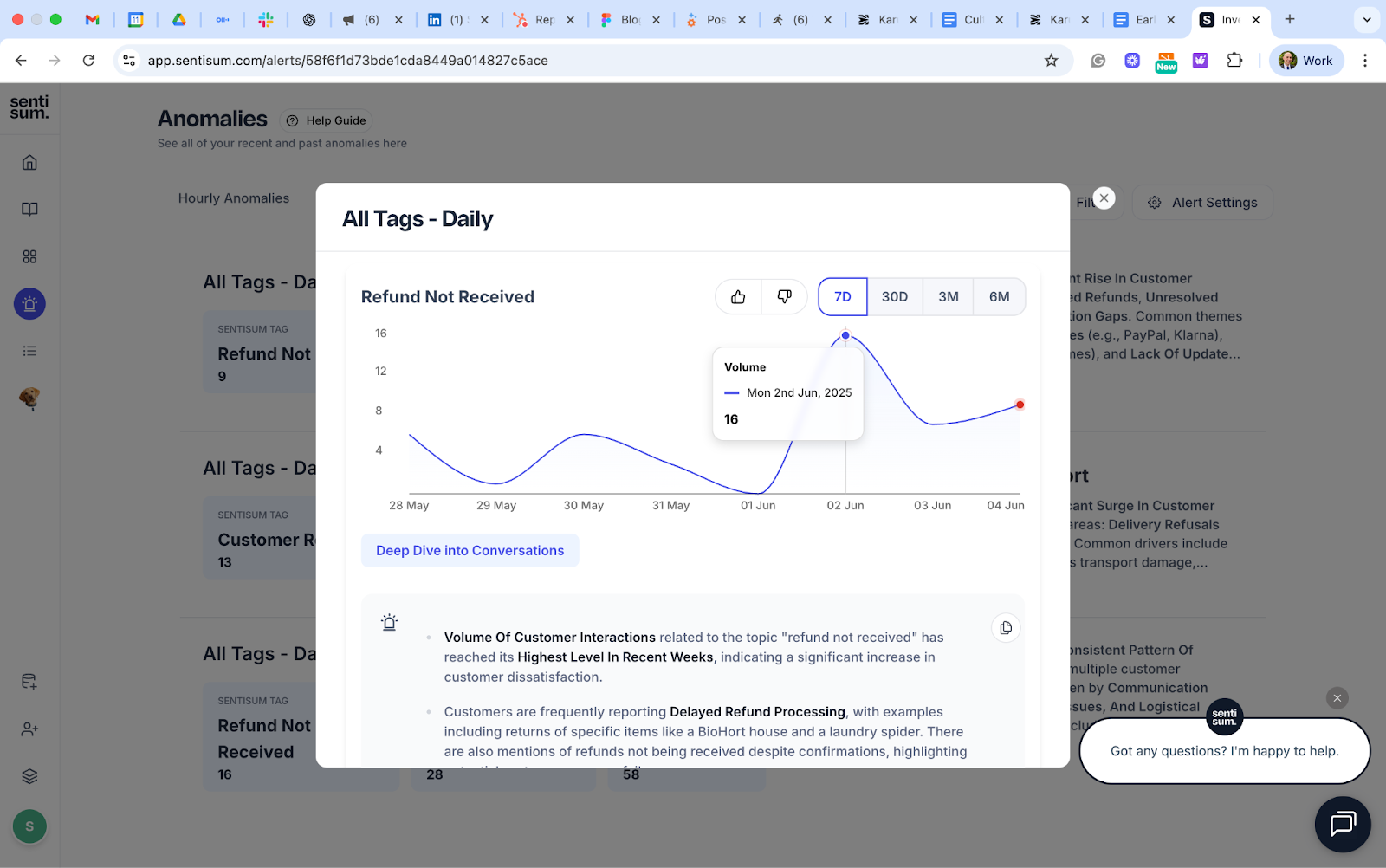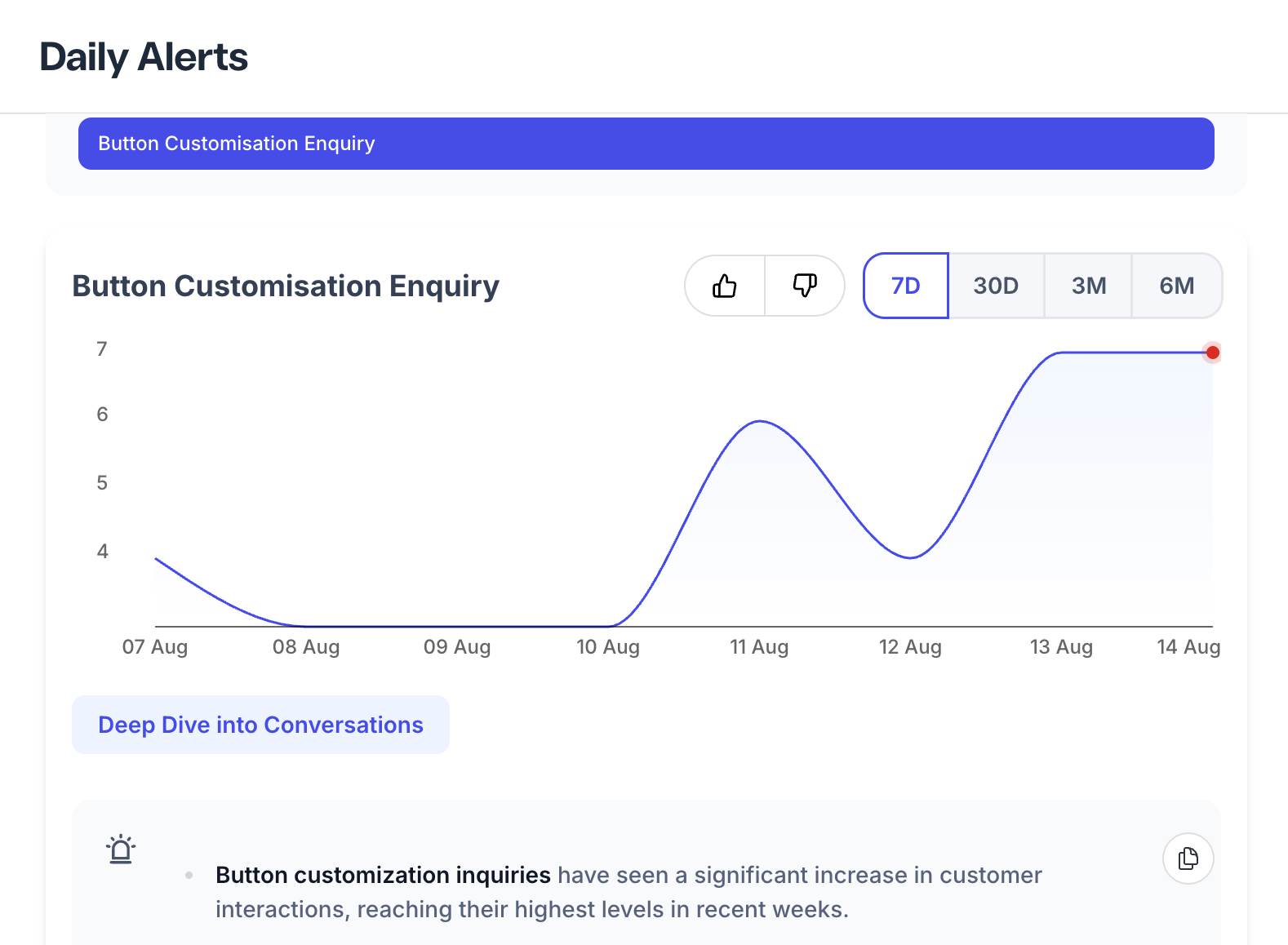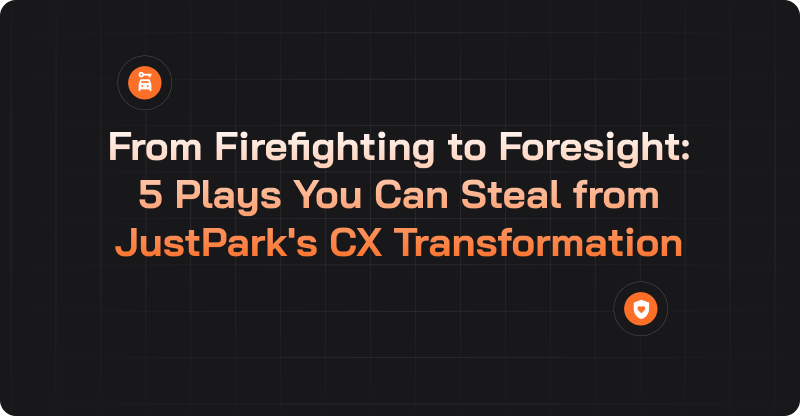Before diving into the stories, here’s what’s happening under the hood.
- Listening everywhere
SentiSum’s AI engine, Kyo, continuously ingests live data from tickets, chats, reviews, and surveys. - Spotting anomalies
AI models detect unusual patterns in keywords, tone, or volume so teams see what’s changing in real time. - Explaining the cause
Each alert includes a summary, the likely root cause, and example quotes that make sense at a glance. - Delivering the alert where work happens
Alerts appear by email, in dashboards, or directly in Slack or Teams. - Closing the loop with Kyo
Teams can simply ask “What’s driving this?” and see the evidence that supports it.

That’s the backdrop for what happens next. Let’s now dive into the three stories.
Leveraging Early Warning Systems to Prevent Churn
In today's fast-paced business environment, proactive monitoring and early detection of issues are crucial to maintaining a seamless customer experience. By spotting potential problems before they escalate, teams can act quickly and prevent costly disruptions. Let’s now dive into the three stories.
1) The 3 a.m. Event Save
One of our customers, a global events platform, had just wrapped up a major concert. Everything looked smooth at 11 p.m.
By 3 a.m., the Early Warning Agent spotted something unusual: a spike in “ticket transfer” mentions and a negative tone in post-event feedback. Kyo’s summary revealed that many fans were unable to transfer tickets to friends after the event. This was due to a small product bug causing growing frustration.
The CX lead received the alert before sunrise, confirmed the issue through a few sample quotes, and passed it straight to the product team. Within hours, the team deployed a simple fix and issued a short message to affected users. By morning, the problem was resolved, and fans were already thanking the brand for the quick response.
💡 Impact: Crisis averted. No PR fallout. No angry threads.
Takeaway: When you can see the signal before it becomes noise, teams align faster, and trust stays intact.
2) The Delivery Spike
A retail logistics customer saw steady ticket numbers midweek, but the Early Warning Agent flagged a 60 percent increase in delivery-related issues centred on one courier region.
The anomaly summary said it clearly: “Missed delivery + DPD + Midlands = significant rise.” Within 24 hours, the team switched to a backup courier and sent transparent updates to customers.
What stood out wasn’t just the speed of the fix, but how quickly different teams rallied around a single source of truth. Operations saw the pattern, Product confirmed the cause, and CX managed expectations with confidence. The alert became the thread that connected everyone working to protect the customer experience.
💡 Impact: Complaints dropped 42 percent that week, and escalation volume fell sharply.
Takeaway: The best insights don’t just highlight a problem, they unite teams around a fast, clear fix that protects the customer experience.
3) The Login Lockout
A consumer app team rolled out an Android update overnight. By morning, reviews started mentioning login problems, but the dashboards still looked calm.
The Early Warning Agent caught the signal: “login failure,” “Android 12,” “auth timeout.” A Slack alert summarised the pattern, and the product lead saw it before support queues spiked.
The team patched the bug and added an in-app banner the same day, turning what could have been a surge of frustrated users into a non-event.
💡 Impact: No downtime, no ticket spike, no customer churn.
Takeaway: Great customer experiences aren’t built by reacting quickly, but by recognising the moment when a small issue becomes a big one.

What These Stories Have in Common
Each story is different, but they share a few principles that show why early awareness changes everything.
• Clarity from noise: patterns surface through real conversations, not reports
• Context with every alert: summaries explain what’s changing and why it matters
• Shared visibility: insights flow instantly between CX, Product, and Operations, so everyone moves together
• Faster recovery: issues are resolved early, before they grow into customer pain
• Continuous learning: every alert sharpens understanding of how customers think, speak, and feel
These moments aren’t just examples of quick fixes; they show how better awareness reshapes how teams work together and how customers experience the brand.
What Makes Sentisum’s Early Warning Agent Different
When we talk about “anomalies” or “signals,” it’s easy to imagine a black box of artificial intelligence quietly deciding what matters and what doesn’t. In practice, that kind of opaque automation doesn’t build user trust or understanding
Our approach is different. We use Explainable AI (XAI); intelligence that shows its working out. Every alert reveals the evidence behind it, from real customer quotes to data patterns and confidence scores. You can see not only that something changed, but why it changed. It’s a deliberate mix of design and transparency that helps teams act with confidence instead of guesswork.

Here are the sequential steps the Early Warning Agent follows to guide a user effortlessly through the process when an anomaly occurs.
1) Your Brand. Your Data. Your AI Model.
The Early Warning Agent goes beyond keywords. It’s trained on your brand’s own data, learning how your customers speak and what really signals risk. It understands sentiment, intent, and the meaning behind phrases like “refund stuck” or “driver late.” That’s how it turns everyday feedback into insight your teams can trust.
2) Topic graphs, not tickets
The Agent maps relationships between themes such as delivery, carrier, region, and tone to see when one variable changes abnormally against its usual context. Understanding those relationships highlights the root cause rather than just the symptom.
3) Statistical process control at scale
Originally developed in manufacturing to detect defects in production lines, this method helps Early Warning Agent understand what “normal variation” looks like in customer data. It applies the same discipline of quality control to CX operations, flagging genuine shifts in behaviour before they affect customer experience.
4) Explainable AI output
Every alert carries its own rationale: sample quotes, confidence scores, and an evidence trail. Teams see why it triggered, not just that it did. That clarity turns AI from an abstract prediction engine into a practical decision tool and a digital teammate you can rely on.
5) Human in the loop learning
Every time users mark an alert as useful or irrelevant, SentiSum’s AI engine Kyo refines its thresholds and language understanding so the next signal is sharper. Over time, it starts to act like your customer second brain, absorbing patterns, remembering context, and surfacing what really matters. The more teams engage, the more the Agent mirrors their judgment, keeping technology and expertise aligned.
What this means for you:
Every example here shows that timely awareness changes outcomes. When teams can see a shift as it happens, they fix the issue before it grows, protect revenue, and strengthen customer trust. The real advantage is not in speed alone but in seeing clearly enough to act with confidence.
If you would like to see how this approach works in practice, explore how JustPark turned fragmented customer feedback into instant, coordinated action across teams. Their story shows what happens when insight moves faster than the problem.
Read how JustPark fixed customer feedback problems before they cost thousands
Heading 1
Heading 2
Heading 3
Heading 4
Heading 5
Heading 6
Lorem ipsum dolor sit amet, consectetur adipiscing elit, sed do eiusmod tempor incididunt ut labore et dolore magna aliqua. Ut enim ad minim veniam, quis nostrud exercitation ullamco laboris nisi ut aliquip ex ea commodo consequat. Duis aute irure dolor in reprehenderit in voluptate velit esse cillum dolore eu fugiat nulla pariatur.
Block quote
Ordered list
- Item 1
- Item 2
- Item 3
Unordered list
- Item A
- Item B
- Item C
Bold text
Emphasis
Superscript
Subscript

.webp)
.png)





.png)

.webp)
.svg)
.svg)







